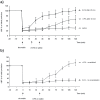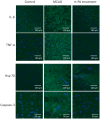Pro-inflammatory mediators and apoptosis correlate to rt-PA response in a novel mouse model of thromboembolic stroke
- PMID: 24465746
- PMCID: PMC3896417
- DOI: 10.1371/journal.pone.0085849
Pro-inflammatory mediators and apoptosis correlate to rt-PA response in a novel mouse model of thromboembolic stroke
Abstract
Background: A recent study suggests that patients with persistent occlusion of the middle cerebral artery (MCA) following treatment with recombinant tissue plasminogen activator (rt-PA) have better outcomes than patients with MCA occlusion not receiving rt-PA. We performed a study to elucidate possible mechanisms of this finding in a new model of thromboembolic stroke closely mimicking human pathophysiology.
Methods: Thromboembolic stroke was induced by local injection of thrombin directly into the right MCA of C57 black/6J mice. Rt-PA was administered 20 and 40 min after clot formation. The efficiency of rt-PA to induce thrombolysis was measured by laser Doppler. After 24 h, all animals were euthanized and interleukin (IL)-6, tumor necrosis factor-alpha (TNF-α), matrix metalloproteinase (MMP)-9, Caspase-3, hsp 32 and hsp 70 protein levels were investigated by immunofluorescence. Presence of hemorrhage was verified and infarct volume was measured using histology.
Results: Thrombin injection resulted in clot formation giving rise to cortical brain infarction. Early rt-PA treatment starting at 20 min after the clot formation resulted in 100% recanalization. However, rt-PA-induced thrombolysis dissolved the clot in only 38% of the animals when administered 40 min after clot formation. Protein levels of IL-6, TNF-α, MMP-9, Caspase-3, hsp 32 and hsp 70 were increased after MCAO, whereas treatment with rt-PA attenuated the expressions of inflammatory markers in those animals where the thrombolysis was successful. In addition, the infarct size was significantly reduced with rt-PA treatment compared to non-treated MCAO, regardless of whether MCA thrombolysis was successful.
Conclusions: The present study demonstrates a clear correlation of the protein expression of inflammatory mediators, apoptosis and stress genes with the recanalization data after rt-PA treatment. In this model rt-PA treatment decreases the infarct size regardless of whether vessel recanalization is successful.
Conflict of interest statement
Figures





Similar articles
-
Characterization of a new model of thromboembolic stroke in C57 black/6J mice.Transl Stroke Res. 2014 Aug;5(4):526-33. doi: 10.1007/s12975-013-0315-9. Epub 2013 Dec 19. Transl Stroke Res. 2014. PMID: 24347404 Free PMC article.
-
Validation of a stroke model in rat compatible with rt-PA-induced thrombolysis: new hope for successful translation to the clinic.Sci Rep. 2020 Jul 22;10(1):12191. doi: 10.1038/s41598-020-69081-0. Sci Rep. 2020. PMID: 32699371 Free PMC article.
-
Magnetic resonance angiography of thromboembolic stroke in rats: indicator of recanalization probability and tissue survival after recombinant tissue plasminogen activator treatment.J Cereb Blood Flow Metab. 2002 Jun;22(6):652-62. doi: 10.1097/00004647-200206000-00003. J Cereb Blood Flow Metab. 2002. PMID: 12045663
-
Role of tissue-type plasminogen activator in ischemic stroke.J Pharmacol Sci. 2010;113(3):203-7. doi: 10.1254/jphs.10r01cp. Epub 2010 Jun 29. J Pharmacol Sci. 2010. PMID: 20595786 Review.
-
A novel mouse model of thromboembolic stroke.J Neurosci Methods. 2015 Dec 30;256:203-11. doi: 10.1016/j.jneumeth.2015.09.013. Epub 2015 Sep 18. J Neurosci Methods. 2015. PMID: 26386284 Free PMC article. Review.
Cited by
-
Ischaemic stroke and the recanalization drug tissue plasminogen activator interfere with antibacterial phagocyte function.J Neuroinflammation. 2017 Jul 21;14(1):140. doi: 10.1186/s12974-017-0914-6. J Neuroinflammation. 2017. PMID: 28732504 Free PMC article.
-
Thrombolysis increases the risk of persistent headache attributed to ischemic stroke: A prospective observational study.Brain Behav. 2024 Mar;14(3):e3447. doi: 10.1002/brb3.3447. Brain Behav. 2024. PMID: 38450944 Free PMC article.
-
Age Progression of Neuropathological Markers in the Brain of the Chilean Rodent Octodon degus, a Natural Model of Alzheimer's Disease.Brain Pathol. 2015 Nov;25(6):679-91. doi: 10.1111/bpa.12226. Epub 2015 Feb 10. Brain Pathol. 2015. PMID: 25351914 Free PMC article.
-
Inflammatory and metalloproteinases profiles predict three-month poor outcomes in ischemic stroke treated with thrombolysis.J Cereb Blood Flow Metab. 2017 Sep;37(9):3253-3261. doi: 10.1177/0271678X17695572. Epub 2017 Mar 7. J Cereb Blood Flow Metab. 2017. PMID: 28266892 Free PMC article.
-
Neurovascular unit disruption and blood-brain barrier leakage in MCT8 deficiency.Fluids Barriers CNS. 2023 Nov 3;20(1):79. doi: 10.1186/s12987-023-00481-w. Fluids Barriers CNS. 2023. PMID: 37924081 Free PMC article.
References
Publication types
MeSH terms
Substances
LinkOut - more resources
Full Text Sources
Other Literature Sources
Medical
Research Materials
Miscellaneous

